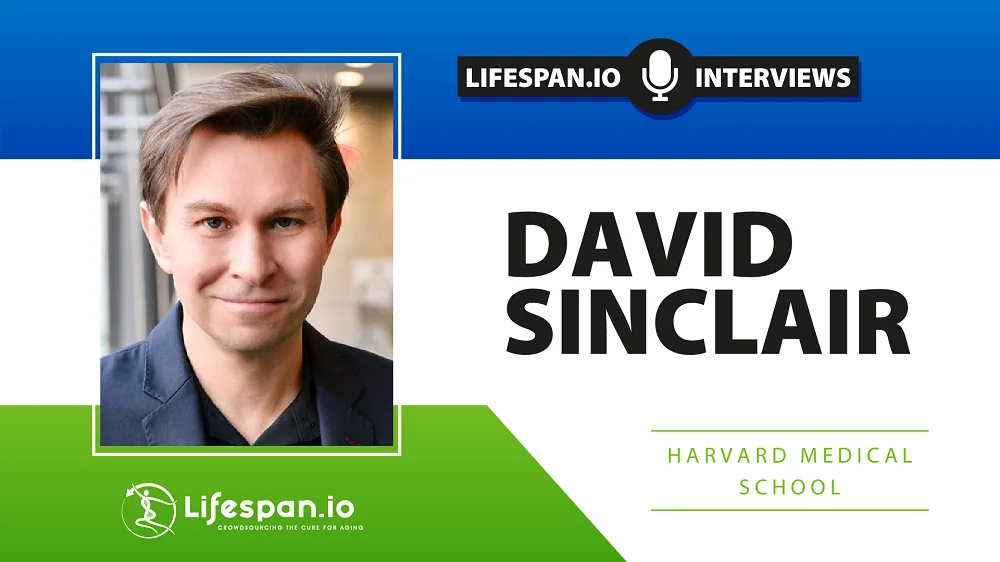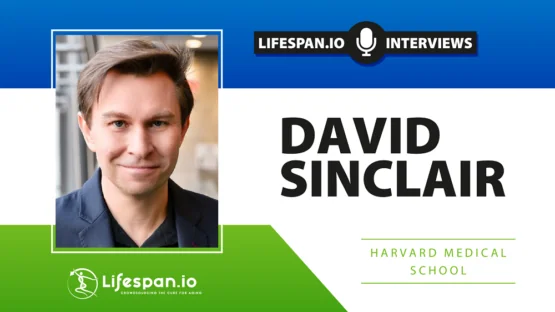In this new interview, David Sinclair, Harvard professor and the author of “Lifespan”, explains his theory of aging, shares parts of his health routine, and reveals which directions in today’s aging research excite him.
A professor and a public figure
In the longevity field, when it comes to name recognition, there’s David Sinclair and all the rest. Like in many other areas, this gap in popularity doesn’t necessarily reflect the actual professional hierarchy. Dr. Sinclair, a Harvard professor, is undoubtedly a very prominent aging researcher, but he would probably agree (although we didn’t ask) that he has many equally worthy colleagues.
Some of Dr. Sinclair’s popularity stems from his highly successful “Lifespan: Why We Age and Why We Don’t Have To”, a great entry-level book that did a lot to introduce the science of aging and the ideology of life extension to the public consciousness. Now, a new book is in the works, and it differs from the first one, Dr. Sinclair told us, in that “Lifespan is the textbook, Lifespan II is the guidebook”. That probably means we can expect some expert wisdom on how every one of us can stay healthier and live longer. Dr. Sinclair maintains an interesting personal routine, which we also asked him about.
Today, Dr. Sinclair is one of the most visible longevity advocates, expertly broadcasting the message of life extension from top-tier platforms such as Joe Rogan’s and Peter Diamandis’ podcasts. He carefully chooses his appearances at conferences, where he receives rock star-like attention.
All this does not mean that Dr. Sinclair has completely morphed into a public figure. On the contrary, he and his team at Harvard continue to produce some of the most interesting results in the field, which we have covered extensively. He is one of the pioneers in practical applications for partial cellular reprogramming, having demonstrated that it can regenerate crushed optic nerves in mice and non-human primates.
The Information Theory of Aging
Like many high-profile researchers, Dr. Sinclair has his pet theory of aging. The current ruling paradigm is the Hallmarks of Aging, the processes that include genomic instability and telomere attrition. Together, they are responsible for the phenotype of aging that we are all familiar with. Scientists know that many if not all these processes are interconnected, but is there an actual hierarchy?
Dr. Sinclair’s answer to that is “yes”. According to his Information Theory of Aging, cells’ health and function depend heavily on epigenetic information, a set of “instructions” in the form of slight chemical alterations to DNA molecules that governs the expression of genes and other elements of our DNA, such as retrotransposons. This is what tells cells into which cell type they should differentiate and how they should perform this type’s duties.
With time, various stressors throw our epigenome into disarray. Imagine pages of a manual being accidentally torn out, having coffee spilt over them, and so on. Epigenetic alterations are indeed one of the Hallmarks of Aging, and their contribution to aging is widely acknowledged. However, Dr. Sinclair takes it one step further.
First, those changes, he says, are responsible for a very significant part of aging – that is, they are high upstream and influence many or all other hallmarks. Second, he postulates that there is a copy of the “manual” that can be used to restore the epigenome to its youthful state. We can see hints to this in cellular reprogramming, where cells can be either thrown back to their pluripotent (undifferentiated) state and almost completely rejuvenated, or partially reprogrammed and partially rejuvenated.
If we can find that pristine backup copy of cellular epigenetic information and learn how to use it, the possibilities are endless. A recent study by Sinclair et al. presents findings in support of the theory. It’s not conclusive evidence yet, but definitely hope-inspiring. For more on this and other topics, we turned to David himself, and he kindly agreed to answer a few questions.
Let’s start with your Information Theory of Aging. In terms of what causes aging, how far upstream are epigenetic changes, according to this theory?
According to the Information Theory of Aging, epigenetic changes that disrupt gene expression patterns as we age are driven by cell stress and damage, such as DNA breaks. This process causes cells to lose their function and identity, to become “exdifferentiated,” and this may be a cause of many of the changes seen during aging, including some major age-related diseases.
You have said that a “whole-body epigenetic reset” is theoretically possible, just like we reset a cell’s clock by reprogramming it. Will this reset result in the elimination of all kinds of damage, or will we need to supplement it with therapies that fix things like extracellular matrix degradation?
It’s not yet known how potent the effects of in vivo epigenetic reprogramming will be. We know it can improve the function of the eye to cure blindness in mice and monkeys and even improve the function of the brain, but whether it can fix the many problems that occur with age in the human body is not known.
One of the theory’s most fascinating postulates is that there is a “backup copy of epigenetic information in every cell”. At last year’s ARDD, you teased: “We think we know where this information is stored” – so, what’s the hypothesis?
The hypothesis predicts that there is chemical information in cells that encodes the youthful structure of the epigenome so that it can be reset, and gene expression can be restored to an earlier age. We know that it is possible to reset gene expression. We don’t yet know for sure how and where this information is stored, but we are working hard to find these answers.
This backup copy supposedly stores information about the cell’s “youthful” state. Is it something like “this is how a healthy differentiated cell looks like”? In other words, to what epigenetic age does the backup copy point to?
The hypothesis is that the backup copy stores the cell’s youthful chromatin structure that controls which RNAs and proteins are expressed. Resetting these structures allows the cell to regain its differentiated state and its youthful functions.
The evolutionary reason behind a full epigenetic reset is obvious: it ensures that in every generation, a brand-new organism is born. But what could be the evolutionary reason for keeping a “backup copy” of a differentiated cell’s epigenome?
The hypothesis is that rejuvenation is important for germ cells and embryos to maintain youth. We speculate the putative backup copy is also important for the rebuilding of damaged organs and tissues. Many species can regrow entire body parts, from limbs to heads. With the exception of our livers, which can regrow after damage or surgery, we humans have largely lost the ability to regrow organs and limbs.
How does negligible senescence fit into the Information Theory of Aging? Do species with negligible senescence accumulate less epigenetic noise, or are they more effective in clearing damage, or both?
Species that live a long time are known to have a more stable epigenome than those that live shorter. We suspect this might be because they are better at preventing and repairing DNA damage, which we have shown can accelerate age-related changes.
You have said that the information theory of aging is compatible with the antagonistic pleiotropy paradigm. Can you explain this in more detail?
Antagonistic pleiotropy is a process that is advantageous when organisms are young, but they cause problems later in life, when the force of natural selection is so weak they continue to exist in the germline. The processes that disrupt the epigenome seem to be useful in young organisms because they recruit chromatin factors to sites of broken DNA and increase DNA repair and stabilize chromosomes. We first saw this in yeast cells in Lenny Guarente’s lab in the late 1990s, then later in mammals, in my own lab in the 2000’s. The problem is that the recruitment doesn’t reset fully, and chromatin regulators lose their place on the genome, causing exdifferentiation of cells. In 2007, we called this the “Relocalization of Chromatin Hypothesis of Aging” or RCM, and it was later incorporated into the Information Theory of Aging.
The idea behind one of your recent papers was that if we induce double strand breaks and faithfully repair them while still getting cellular damage, that will mean that this damage happened due to epigenetic changes. A claim that I’ve heard is that the compound you used to induce DSBs, I-PpoI, is cytotoxic, so the cellular damage observed could have been a result of this cytotoxicity.
We have not seen any evidence for this claim after a decade of studying the system, the results of which are in the paper showing cells do not experience cytotoxicity. Our detailed response to the claim has been published in Cell.
You have the highest media profile and name recognition in the field, so your voice bears a lot of weight. What are your thoughts on the current situation with longevity advocacy?
We have a long way to go. Most people haven’t heard of aging research or the results that are being produced. Most doctors are also unaware of the advances in the field.
What are the bottlenecks in today’s aging research, and how can we eliminate them?
I think our biggest bottleneck is having access to old mice that we can study. One solution would be to have a source of them for all researchers.
Recently, you have said things like “there is no upper limit on human aging”. You have discussed reaching Longevity Escape Velocity as a real possibility. Just a few years ago, this would have raised a lot of eyebrows in the field. What has changed?
Saying there is no known upper limit doesn’t mean we can live for decades or centuries longer. I don’t know of any technology that would allow Longevity Escape Velocity currently, but I also know saying something is “impossible” is a dangerous thing in this time of human history.
What recent developments and discoveries in the longevity field are you excited about?
I’m excited about senolytics, epigenetic reprogramming, and the use of AI in healthcare.
Do you believe we will be able to rejuvenate people our age (I’m just a few years younger than you), or can we only hope to slow aging?
I have hopes we will be able to rejuvenate people in the next few decades. If all goes well, Life Biosciences will be testing vision restoration in humans in 2025.
Let’s talk about your health routine. You describe yourself as “a struggling vegan” and practice intermittent fasting. Are those two things firmly backed by science, or do we only have anecdotal evidence for them?
I’m not simply relying on anecdotes. Changing my lifestyle has resulted in changes to my blood biomarkers that are consistent to long-term health. Vegan diets are considered some of the healthiest of all, and this is backed by multiple human studies. Skipping meals so that my eating window is shorter, which is what I try to do, is backed by evidence indicating that it improves metabolic health and lowers inflammatory markers, among other benefits.
Same question about you taking rapamycin and metformin. Given that the human data is insufficient (and with metformin, contradictory), how can we know those two drugs are safe and effective, especially in combination?
We know their safety profile. Metformin has been in tens of millions of people. Metformin and low-dose rapamycin appear to be relatively safe. Whether they are effective at slowing aging and safe in combination is not yet known.
After this interview was taken, David Sinclair has stepped down as President of the Academy for Health & Lifespan Research, as announced on X by another co-founder, Nir Barzilai.



